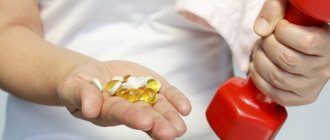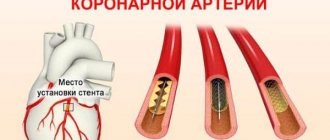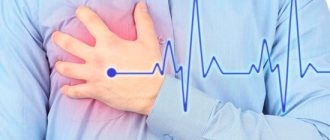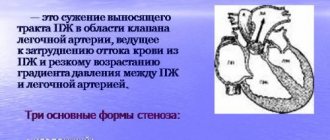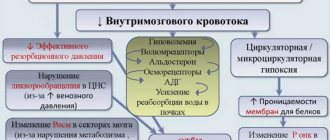- What symptoms of a microinfarction do women experience?
- What symptoms of a microinfarction do men experience?
- General signs of microinfarction
- Causes
- What complications does a microinfarction lead to?
- How to act if you suspect a small focal infarction
- Therapy
- Prevention for people with heart disease
- General methods of prevention
“Microinfarction” is the popular name for the disease - small-focal myocardial infarction. Often the symptoms of the disease are attributed to fatigue or a cold, so many do not attach importance to the ailments they experience during an attack.
The cause of myocardial infarction is disruption of blood flow to the heart muscle due to a blood clot that blocks a coronary artery.
A heart attack can be recognized by chest discomfort, fever, weakness and aching bones.
What symptoms of a microinfarction do women experience?
The disease is very “insidious”, since the symptoms of a microinfarction in women are not always noticeable. Because of this, the diagnosis is made after the fact when other diseases occur.
One of the first symptoms is sudden chest pain. Pain may be present in the left side of the shoulder girdle, shoulder blade and jaw.
According to statistics, women are less likely to pay attention to the symptoms of a heart attack, as they are less sensitive to pain. Also, microinfarction often goes unnoticed by patients over 55-60 years of age and diabetics.
What symptoms of a microinfarction do men experience?
Men experience microinfarction less often and usually do not endure it on their feet. The first sign is chest pain, however, unlike women, men feel radiating pain in the abdomen. There may be a sensation of a foreign object in the chest. In men, the symptoms are more pronounced. During an attack, the patient may experience cold sweat, increased anxiety, bluish lips and an increase in body temperature up to 38 degrees.
Despite the fact that the risk of a small-focal heart attack is lower in men, the likelihood of encountering a real heart attack in the stronger sex is higher, since they are more susceptible to stress.
Characteristics of the pathology
Fine-focal damage to myocardial cells followed by necrosis occurs as a result of:
- incomplete closure of the lumen of the vessel;
- the presence of collateral blood flow pathways;
- complete blockage of small arteries.
All these factors lead to subtle changes that rarely lead to complications. But with a repeated attack or disruption of the patency of several small-caliber vessels at once, the pathology can develop into a large-focal process with severe symptoms and serious consequences.
There are two types of microinfarction: intramural (located deep in the myocardium and does not affect the inner and outer layers) and subendocardial (on the inner lining of the heart). In the first case, a negative T wave is recorded on the ECG in the area of the disorder. In the second, the ST segment shifts below the isoline, as can be seen in the photo:
General signs of microinfarction
Since the symptoms of a microinfarction can easily be confused with a regular illness, it is important to pay attention to the appearance of several signs at the same time.
What symptoms indicate a microinfarction:
- increased temperature, which causes necrosis of cardiac tissue;
- feeling of pain and aches in the joints;
- dizziness, weakness, possible loss of consciousness;
- swelling;
- sudden pain in the chest, radiating to the stomach, shoulder, shoulder blade;
- the appearance of shortness of breath, acute lack of air;
- pain in the solar plexus area;
- cyanosis of the nasolabial triangle, lips.
Usually the attack lasts 40 minutes, and if no serious consequences occur, the symptoms go away. But this does not mean that they can be ignored. If signs of a microinfarction appear, you should immediately consult a doctor.
Authorized Products
It is necessary to consume foods high in lipotropic substances (dissolving fats), vitamins, potassium (it improves heart function), calcium and magnesium.
You also need those products that have a mild effect of enhancing intestinal motility and preventing constipation.
Sugar must be partially replaced with honey, which is a plant biostimulant. In addition, honey contains a large amount of vitamins and microelements.
Animal fats must be replaced with vegetable oils; they contain many vitamins and have a beneficial effect on intestinal motility.
The diet is gradually expanding.
The list of permitted products includes (by diet):
- bread and flour products: diet No. 1 - crackers or dried bread, diet No. 2 - day-old bread up to 150g, in diet No. 3 the amount of day-old bread made from premium flour or rye is increased to 250g.
- soups: ration No. 1 - soups cooked in vegetable broth with pureed vegetables or boiled cereals up to 150 - 200 g, rations 2-3 - soups in vegetable broth with boiled cereals and vegetables (borscht, beetroot soup, pureed carrot soup);
- meat, poultry and fish: non-fatty varieties (veal is healthy), all meat is freed from films and fatty deposits, tendons, skin; in diet No. 1 steamed cutlets, meatballs, dumplings, boiled fish are allowed, in rations 2 - 3 meat, fish or poultry boiled in one piece is allowed;
- dairy products: milk only for tea or dishes, low-fat kefir, pureed cottage cheese, soufflé, low-fat and unsalted cheeses, sour cream only for seasoning soups;
- eggs: only white omelettes or egg flakes in soups;
- cereals: up to 100-150g. semolina porridge, pureed buckwheat or boiled oatmeal in diet No. 1, in diet 2 liquid and viscous, but not pureed porridges are allowed, in diet No. 3 up to 200g is allowed. porridge, a small amount of boiled vermicelli with cottage cheese, casseroles and puddings made from semolina, buckwheat, cottage cheese;
- vegetables: in ration 1 only pureed vegetables (mashed potatoes, beets, carrots), ration no. 2 allows boiled cauliflower, grated raw carrots, in ration no. 3 - stewed carrots and beets; the volume of dishes should not exceed 150g.
- snacks: prohibited in rations 1 and 2, in ration 3 soaked herring, low-fat hams, jellied meat and fish dishes are allowed;
- sweets: in the 1st diet - puree, mousses and jellies from berries and fruits, dried fruits (dried apricots, prunes), a small amount of honey, in the 2nd and 3rd diet the menu is expanded with soft and ripe berries and fruits, milk jelly and jelly, meringues, the amount of sugar increases to 50g;
- spices and sauces: lemon and tomato juices in small quantities in dishes in rations 1 and 2, vanillin, 3% vinegar, sauces based on a decoction of vegetables and milk, citric acid;
- weak tea with lemon or milk, decoction of rosehip, prunes, juices: carrot, beetroot, fruit.
Causes
In 95% of cases, myocardial infarction is associated with blockage of an artery by a blood clot. The cause of illness is a lack of oxygen and nutrients in the heart muscle.
The supply of oxygen in the heart cells lasts for 10 seconds. Over the next 30 seconds, the muscle remains viable, after which the pathological process begins. 3-6 hours after the onset of the attack, the heart muscle in the damaged area dies. If a small area has died, then the infarction is considered small-focal.
The clinical picture of the disease is varied, which makes diagnosis difficult, and it can be difficult for specialists to confirm the disease in a short time.
The diagnosis is based on 3 indicators:
- medical history, complaints of pain typical of a heart attack;
- ECG indicators;
- results of a biochemical blood test.
If the doctor has doubts, he may prescribe additional studies, for example, identifying the lesion using the radioisotope method.
Case from practice
A 54-year-old woman came to the clinic with complaints of weakness and nausea.
The problem was associated with malnutrition. During the interview, it turned out that she had been experiencing angina pectoris for 10 years; attacks occurred several times a month and were relieved with Nitroglycerin. The ECG shows signs of acute ischemia along the lower wall of the left ventricle, without the formation of a Q wave. Diagnosis: Small focal infarction.
The woman completed a full course of treatment in hospital, her condition improved, and she was discharged under the supervision of a local cardiologist. Recommended: following a diet, taking Aspirin Cardio, Metoprolol, Atrovastatin.
How to act if you suspect a small focal infarction
The first thing to do is call an ambulance. Pre-medical care for the patient consists of creating conditions of maximum comfort in order to alleviate the condition.
The patient needs to take a lying or semi-lying position, ensure a flow of fresh air into the room (avoid drafts). Eliminate light and sound stimuli. If necessary, remove the patient from restrictive clothing. For medications, you can use nitroglycerin (dissolve under the tongue) or Corvalol (30-40 drops).
Treatment tactics
Treatment for a microinfarction can only be prescribed by a doctor. He does this based on the results of the examination. Typically, therapy consists of taking drugs that have the following effects:
- dilatation of heart vessels;
- resorption of blood clots;
- blood thinning;
- relief of pain;
- correction of electrolyte disturbances.
But drug treatment is only part of the therapy. Patients are given a number of recommendations that must be followed to avoid relapses and complications:
- emotional peace;
- moderate physical activity;
- walks in the open air;
- diet;
- full eight-hour sleep;
- rejection of bad habits.
If you neglect the prescriptions and recommendations of doctors, you can face quite serious consequences of a microinfarction. This may be worsening heart failure, recurrent myocardial infarction, thromboembolism, pericarditis and other ailments.
You need to understand that a healthy lifestyle is an important component of a person’s well-being. Even when the MI is over, one should not forget about the above recommendations, because people who have had an attack have a predisposition to its reappearance. Relapse may be more serious. In addition, physical activity and proper nutrition will help you avoid many other diseases.
Therapy
The patient is taken to intensive care, where complex therapy is carried out. When treating a heart attack, the speed of reaction is very important: the faster the patient gets to the hospital and receives proper care, the higher the chances of a positive outcome and the absence or minimum number of complications.
Doctors use drugs that help dissolve a blood clot, painkillers, and medications to lower blood pressure and reduce blood circulation. Also, as part of treatment, it is necessary to achieve a decrease in heart rate, which is achieved by taking beta-blockers.
The rehabilitation period after inpatient treatment is no less important than the therapy itself. The recovery period lasts up to 6 months. The patient may be prescribed medications that must be taken constantly. Also, to maintain normal condition, it is necessary to follow a diet, in particular, eliminating fatty and fried foods from the diet, as well as stopping smoking and drinking alcohol.
If the doctor's recommendations are followed, the patient can count on a long and fulfilling life.
Diagnostics
Understanding that a microinfarction is a condition that is very dangerous to health, at the first sign of it you need to call an ambulance. After taking the first measures to alleviate the person’s condition, he will be taken to the hospital, where the examination will be carried out. It is as follows:
- physical examination of the patient;
- collecting anamnesis, studying medical history;
- measuring blood pressure and pulse;
- taking an ECG;
- Ultrasound of the heart.
The patient must also donate blood and urine for analysis and undergo Holter monitoring if indicated. It will allow you to track the work of the heart over a long period of time, obtaining the most complete information about the patient’s condition.
Prevention for people with heart disease
People with chronic diseases of the cardiovascular system need to undergo an annual medical examination in order to receive timely and adequate medical care.
As a preventive measure, patients with coronary heart disease are prescribed an assessment of the condition of the coronary arteries, during which the degree of narrowing and localization of atherosclerotic plaques will be identified. If necessary, the vessels are expanded from the inside using angioplasty. Another method is to implant a metal frame into the artery. It will prevent the passage from narrowing.
Some patients are prescribed coronary artery bypass grafting. During the operation, additional vessels are transplanted to the aorta, which go around the narrowing site and create additional pathways for blood flow to the heart.

